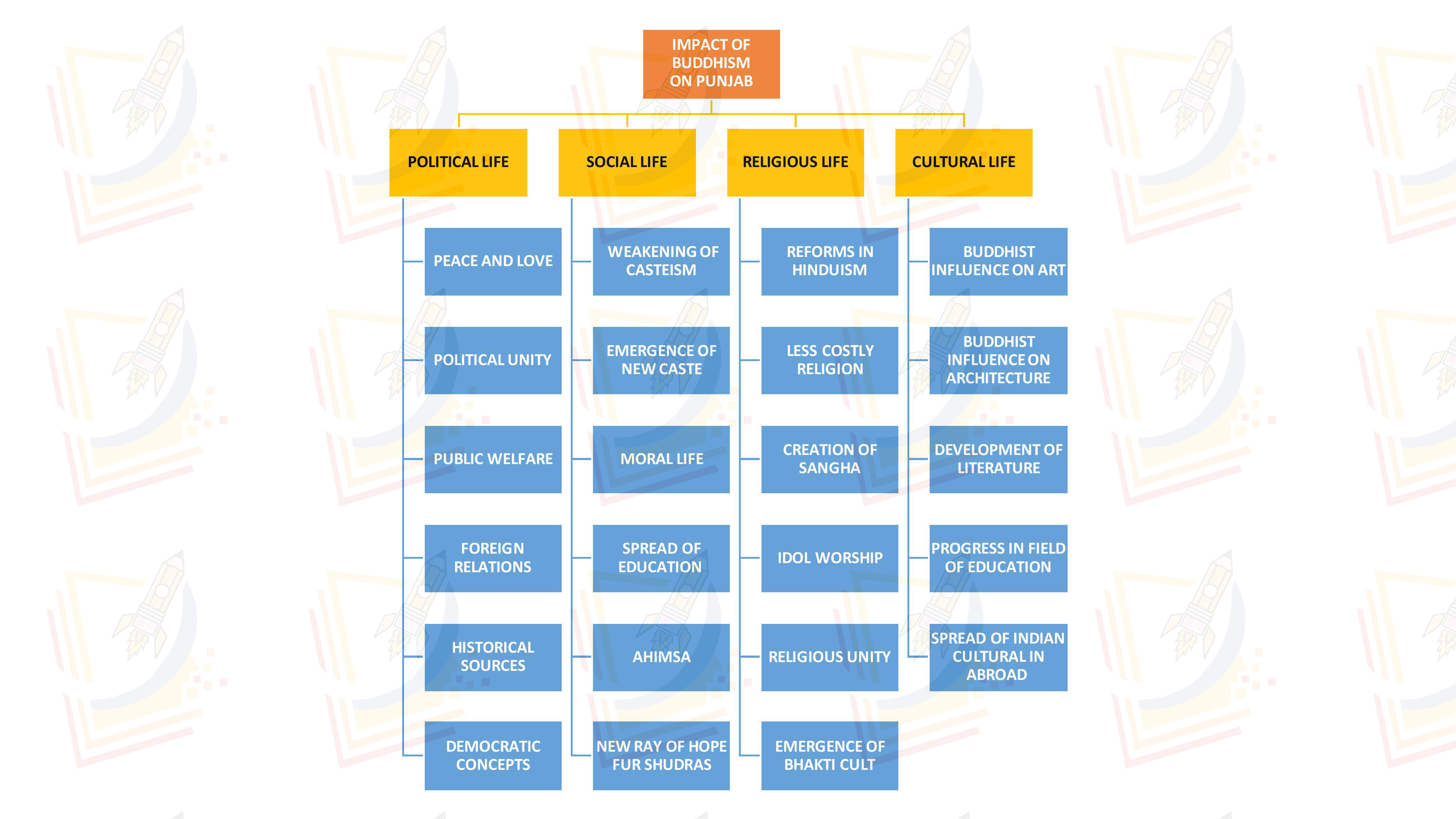INTRODUCTION :
The childhood name of Gautam Buddha was Siddhartha while he was also known as Sakyamuni or Tathagata because he belonged to the Sakya clan, his family name was Gautam. He was a kshatriya prince and son of Suddhodana , the Sakya ruler of Kapil astute in Nepal. Buddhism is considered to be the greatest religion , and received special attention when Ashoka embraced Buddhism . It was Kushanas who played a vital role in rendering meritorious services for consolidating the roots of Buddhism in Punjab.

POLITICAL LIFE : -
- PEACE AND LOVE : Buddha laid emphasis on harmony, peace and brotherhood and opposed war. Rulers like Ashoka were fascinated by non violence and opposed the wars.
- POLITICAL UNITY : Buddha focused on brotherhood and wanted to foster unity among Indians. Under Ashoka, India was able to gain political unity.
- PUBLIC WELFARE : public welfare was promoted under Buddhism , under whose influence rulers like Ashoka took more interest in the welfare of the citizens for which he constructed hospitals, roads, wells etc.
- FOREIGN RELATIONS : With the promotion of brotherhood Buddisms helped a lot in creation of close foreign relations of India. Buddhist monks went abroad where they spread Buddhism and created trade links between India and other countries.
- HISTORICAL SOURCES : Buddhist works like , " Tripitakas" , "jatakas" etc provide important information about our life and works of rulers in India.
- DEMOCRATIC CONCEPTS : Buddhist Sangha contained democratic values which popularised the democratic concept in India.
SOCIAL LIFE :
- WEAKENING OF CASTEISM : Lord Buddha denied the caste system. According to him, the caste of a person is defined by his deeds and moral character. Buddhism imposed strong opposition on the caste system and focused on equality of every man.
- EMERGENCE OF NEW CASTE : Buddhism was divided into 18 sects , each sect formed its own distinct caste while some went back to Hinduism , which created many castes in Hinduism.
- MORAL LIFE : Buddhism focused on moral life which reduced many social issues and developed social welfare.
- SPREAD OF EDUCATION : There were many Buddhist centres of preaching such as Buddhist Sangha, monasteries etc. Students of not only India but from foreign nations flocked to importers of learning like Nalanda, Taxila etc to acquire higher education.
- AHIMSA : Buddhist focused on spread of non violence and peace. They opposed the wear and adopted the path of ahimsa.
- NEW RAY OF HOPE FUR SHUDRAS : as Buddhism denied caste system, so shudras who were ill treated by Hindus were welcomed by Buddhism.
RELIGIOUS LIFE :
- REFORMS IN HINDUISM : Hinduism reformed itself as per time needed , Hindus acknowledged Buddha as incarnation of Vishnu and accepted the principle of Ahimsa. Shudras were treated well.
- LESS COSTLY RELIGION : Buddhism was the religion with no or less religious practices unlike Hinduism who demanded high ritualistic values, sacrifices etc.
- CREATION OF SANGHA : Lord Buddha set up the Sangha to preach the ideas and teachings, these Sanghas became very popular and a great centre of Buddhist learnings.
- IDOL WORSHIP : With Maharana sect of Buddhism's the idol worship became popular among Buddhist and people began to worship the idols of lord Buddha.
- RELIGIOUS UNITY : Caste system came to end through Buddhism, it removed distinction between high and low which created unity among people.
- EMERGENCE OF BHAKTI CULT : According to various historians the bhakti cult us the outcome of Buddhism.
CULTURAL LIFE :
- BUDDHIST INFLUENCE ON ART : With the influence of Buddhism many rulers like Ashoka built stupas, monasteries, pillars etc. idol images of Buddha were also created which shows art patterns of those times.
- BUDDHIST INFLUENCE ON ARCHITECTURE : Buddhism made great contributions in the field of architecture, the caves of Ajanta and Ellora, the main theme of painting is the life of Buddha. The Sanchi stupas , stone pillars are other great examples.
- DEVELOPMENT OF LITERATURE : Buddisms contributed in the development of literature like deans and poetry. Tripitakas and Jatakas occupy the same high position as vedas. These books were translated into various languages like Pali.
- PROGRESS IN FIELD OF EDUCATION : Buddisms contributed in the field of education, creation of Buddhist Sangha became the centre of learning, while Universities like Taxila,Gaya, Nalanda etc. , became Mai. Centres of education. Nalanda University was called the Oxford of Buddhism.
- SPREAD OF INDIAN CULTURAL IN ABROAD : Buddhist monks went to foreign countries like China, Haian, Ceylon, Burna etc., where they spread the culture of India and Buddisms became popular in these regions.
CONCLUSION :-
From the above it can be concluded that Buddhism was the great religion which brought great impacts on social, political and cultural life of people. Untiring efforts of Buddhists monks also spread the religion in fire in countries like China, Hayan, Bali, Burma etc. It helped in the spread of Indian culture.
BOOK REFRENCE ( CLICK TO BUY )
A History of India, Vol. I, Penguin Books, 1966 - Thapar, Romila
